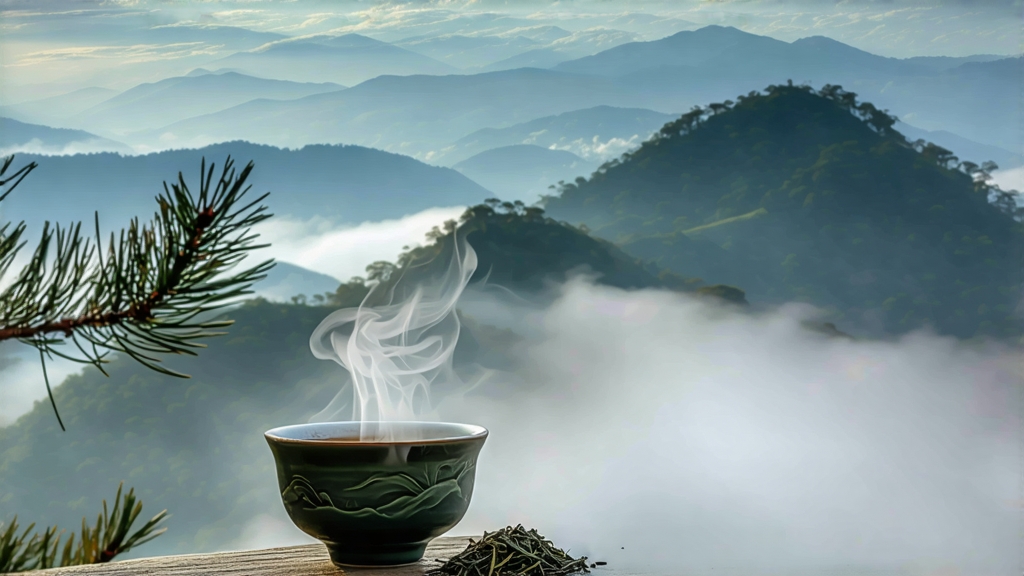
Ask most tea lovers to name the first black tea ever created and they will probably hesitate; mention Lapsang Souchong, however, and eyes light up with images of crackling pine fires and deep, resinous aroma. Hailing from the Wuyi Mountains of Fujian Province, this remarkable tea—called Zheng Shan Xiao Zhong in its homeland—carries within its curled, ebony leaves the very DNA of black tea history. When Dutch merchants unloaded the earliest kegs of “bohea” in 1600s Europe, the dark liquor that seduced London and Amsterdam was Lapsang Souchong; it defined what “black tea” meant before India, Sri Lanka or Kenya had even planted a single bush. Understanding this tea is therefore a journey into both Chinese craft and the globalization of taste.
The Wuyi massif is a UNESCO World Heritage basalt-and-granite labyrinth where narrow gorges trap humid fog, giving rise to the mineral “rock rhyme” (yan yun) prized in all Wuyi teas. Within this protected core—known as Zheng Shan, or “Original Mountain”—only leaves picked above 600 m within a 60 km² radius may bear the authentic name. Outside that circle the same cultivars produce perfectly pleasant black tea, yet it lacks the subtle cliff-orchid fragrance and cooling camphor finish that connoisseurs seek. Two predominant cultivars dominate: Cai Cha, a hardy shrub whose small leaves concentrate sugars, and the more recent Wuyi Qizhong series, bred for elegance. Between Qingming and the early-May rains, pickers pluck one bud and two or three leaves, judging the exact moment when the bud stands erect but the third leaf still snaps crisply.
Withering begins the moment baskets descend the mountain. In the traditional “green-house” method, fresh leaf is spread on bamboo screens set over dying embers of local Masson pine; the warm updraft circulates resinous smoke while de-enzyming the leaf. Modern hygienic workshops now use electrically heated tunnels, yet the finest lots still insist on pine-wood with bark removed to avoid tar. After 6–8 hours the leaves lose about 65 % moisture, turning velvety to the touch. Rolling comes next: for 45 minutes the withered leaf is bruised under 35 kg granite rollers, rupturing cells so that polyphenols meet oxidase in the mountain air. Oxidation is brief—barely 90 minutes—because Wuyi’s cool nights slow enzymatic browning; masters watch for the leaf edge to turn chocolate while the vein remains olive. A final 120 °C bake halts oxidation, but here Lapsang Souchong diverges from all other black teas: half the batch enters a pinewood smoking room where layers of tea rest over smouldering pine twigs for up to eight hours. The smoke is not allowed to flame; resin vapor drifts upward, condensing on leaf surfaces and forming the characteristic phenolic film that gives the tea its signature note of longan, pine honey and winter campfire.
Grading follows a rustic yet precise nomenclature. The top grade, Wu Shan (Original Mountain), comprises only spring buds, golden tipped and almost entirely smoke-free because the delicate hairs absorb too much resin; instead these leaves are dried over charcoal for a subtle biscuity aroma. Next comes Te Ji (Special Grade), the classic export profile: well-smoked, with a glossy obsidian colour and the scent of burnt caramel. Third grade, Ji Pin (Gift Grade), balances smoke and sweetness for everyday gongfu brewing. Finally, Piao Xiang (Floating Fragrance) designates the lightly smoked autumnal leaf favoured in Russia and Central Asia for samovar boiling.
To brew Lapsang Souchong well, one must decide whether to highlight its sweet Wuyi terroir or its smoky swagger. For the former, use a porcelain gaiwan of 120 ml, 4 g of leaf, and 90 °C water. Rinse once to wake the leaf, then steep 8 s, adding 2 s each subsequent infusion. The first cup delivers orchid and dried longan; the second, cocoa and roasted walnut; by the fifth, a cool camphor lingers on the breath. If you crave campfire, reach for a 200 ml Yixing pot seasoned only with black teas, raise water temperature to 95 °C